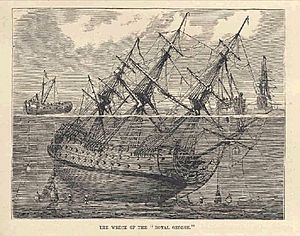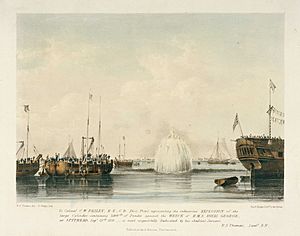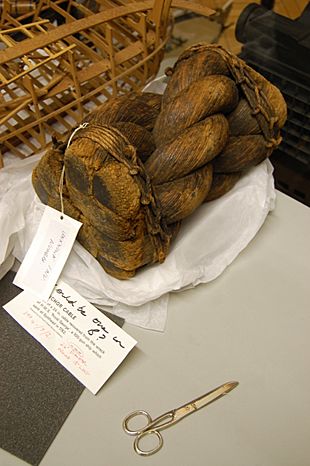HMS Royal George (1756) facts for kids
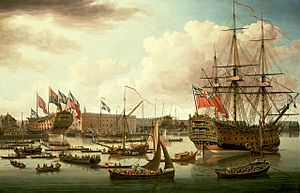
HMS Royal George (right) shown fictitiously as already afloat during the launch of HMS Cambridge in 1755. Painted by John Cleveley the Elder in 1757.
|
|
Quick facts for kids History |
|
|---|---|
| Name | HMS Royal George |
| Ordered | 29 August 1746 |
| Builder | Woolwich Dockyard |
| Laid down | 8 January 1747 |
| Launched | 18 February 1756 |
| Commissioned | October 1755 (before launch) |
| Fate | Foundered, 29 August 1782, at Spithead |
| Notes |
|
| General characteristics | |
| Class and type | 1745 Establishment 100-gun first-rate ship of the line |
| Tons burthen | 2047 bm |
| Length |
|
| Beam | 51 ft 9.5 in (15.8 m) |
| Depth of hold | 21 ft 6 in (6.6 m) |
| Propulsion | Sails |
| Sail plan | Full-rigged ship |
| Armament |
|
HMS Royal George was a huge warship of the Royal Navy. It was a first-rate ship, meaning it was one of the largest and most powerful ships of its time. It had 100 guns spread across three decks. When it was launched on February 18, 1756, it was the biggest warship in the world. Building it at Woolwich Dockyard took ten years!
The ship quickly joined the Seven Years' War. It was the main ship for Admiral Sir Edward Hawke during the famous Battle of Quiberon Bay in 1759. After that war ended in 1763, the ship was put away for a while. But it was brought back into service in 1777 for the American Revolutionary War. It then served as the main ship for Rear Admiral Robert Digby at the Battle of Cape St Vincent in 1780.
Sadly, Royal George sank on August 29, 1782. It was anchored at Spithead near Portsmouth. The ship was tilted on purpose so workers could fix its hull. But it tilted too much and became unstable. Water rushed in, and the ship sank quickly. More than 800 people died, making it one of the worst sea disasters in British waters.
People tried many times to raise the ship. They wanted to get back valuable items and also remove it because it was a danger to other ships. Divers used special equipment, like diving bells and early diving helmets, to recover cannons and other items. Later, in the 1800s, engineers used gunpowder to break up the wreck. This helped clear the area for other ships.
Contents
A Giant of the Seas
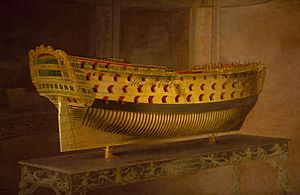
The British Navy wanted to build better ships after some problems in earlier wars. So, on August 29, 1746, they ordered a new 100-gun ship. It was first called Royal Anne, but its name was changed to Royal George while it was being built. Construction started in 1746 at Woolwich Dockyard.
Building the ship took a long time. It wasn't finished until 1756, just before the Seven Years' War began. Even before it was launched, it was made ready for duty in October 1755. Captain Richard Dorrill was its first commander. When it finally launched on February 18, 1756, Royal George was the largest warship in the world. It weighed over 2,000 tons! People saw it as a very powerful weapon.
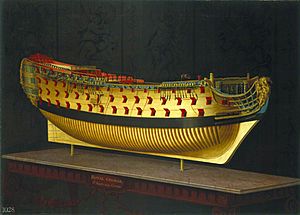
Royal George joined the main British fleet, called the Western Squadron, in May 1756. This was right when the Seven Years' War started. The ship served as the main ship for important admirals like Edward Boscawen and Lord George Anson. In November 1759, it became Admiral Sir Edward Hawke's flagship. From Royal George, Hawke led the fleet in the famous Battle of Quiberon Bay on November 20, 1759. During this battle, Royal George helped sink the French ship Superbe.
After the war, in December 1762, the ship's crew was sent home. Royal George was then put away, like most other large warships, because it was very expensive to keep them ready. While it was stored, the ship had a big repair job done at Plymouth between 1765 and 1768.
The ship was brought back into action when the American War of Independence started in 1775. It was refitted at Portsmouth from 1778 to 1779. Royal George joined the Channel Fleet again. It served as the flagship for several admirals, including Sir Robert Harland and Sir John Lockhart Ross. In January 1780, Royal George helped Admiral Sir George Rodney's fleet. They attacked a Spanish convoy and then fought in the Battle of Cape St. Vincent. This helped bring supplies to Gibraltar.
After returning to Britain, Royal George had its hull covered with copper in April 1780. This helped protect the wood from worms. It continued to serve with the Channel Fleet under different admirals. In 1782, it joined the fleet led by Richard Howe.
The Tragic Sinking


On August 28, 1782, Royal George was getting ready to sail with Admiral Howe's fleet. They were going on another mission to bring supplies to Gibraltar. The ships were anchored at Spithead to take on supplies. Most of the crew were on board. Many workers were also there to help with repairs. A large number of family members were visiting the sailors.
On the morning of August 29, work began on the ship's hull. To do this, Royal George was tilted over. This was done by moving the heavy guns on the starboard (right) side towards the center of the ship. This made the ship lean to its port (left) side. Then, many heavy barrels of rum were loaded onto the low port side. This added more weight and made the ship even more unstable.
The ship tilted too far. It passed the point where it could stay balanced. The ship's carpenter realized the danger. He told the officer in charge, Monin Hollingbery, that they needed to straighten the ship. But the officer refused. As the situation got worse, the carpenter asked again. He was refused a second time. The carpenter then went directly to the ship's captain, who agreed and ordered the guns to be moved back.
However, by then, too much water had already poured into the ship through its open gun ports on the port side. The ship suddenly tilted heavily to port. Water rushed in, and air burst out the other side. A smaller boat that was unloading rum got caught in the masts as the ship turned. This briefly slowed the sinking but most of its crew were lost. Royal George quickly filled with water and sank.
Around 900 people died, including many women and children who were visiting. Only 255 people were saved. Some escaped by climbing the ropes and sails. Others were rescued by boats from nearby ships. Admiral Richard Kempenfelt was in his cabin and could not escape. The ship's captain, Waghorn, was injured but rescued. The carpenter survived the sinking but died later.
Many of the victims' bodies washed ashore at Ryde, on the Isle of Wight. They were buried in a large grave along the beach. Today, a memorial plaque in Ryde remembers the loss of Royal George.
An investigation later said the accident was due to the ship's timbers being old and decaying. It suggested that part of the ship's structure broke under the stress of tilting.
A special fund was started to help the widows and children of the lost sailors. This fund later became the Lloyd's Patriotic Fund. The poet William Cowper wrote a famous poem about the sinking:
Toll for the brave
The Brave that are no more,
All sunk beneath the wave,
Fast by their native shore.
Attempts to Recover the Ship
Many attempts were made to raise the ship. People wanted to get back valuable items. Also, the sunken ship was a big danger to other ships in the busy harbor. It lay only about 65 feet deep.
In 1782, a man named Charles Spalding used a diving bell he designed. He recovered six iron 12-pounder guns and nine brass 12-pounders.
Deane Brothers' Dives (1834)
No more work was done on the wreck until 1834. That's when Charles Anthony Deane and his brother John started working. They used the first air-pumped diving helmet they had invented. From 1834 to 1836, they recovered many more cannons. They found 7 iron 42-pounders, 18 brass 24-pounders, and 3 brass 12-pounders. The rest of the guns were buried in mud and wood.
During this time, local fishermen asked the Deane brothers to check something on the seabed. Their nets kept getting caught on it. John Deane dived about 1 kilometer north-east of Royal George. He found wood and guns from the Mary Rose. This was the first time that famous ship's resting place had been found in centuries!
Pasley's Explosions (1839)
In 1839, Major-General Charles Pasley of the Royal Engineers began a new effort. Pasley had used gunpowder to clear old wrecks in the Thames River before. His plan was to break up the Royal George wreck using gunpowder charges. Then, divers would recover as much as possible. The charges were made from oak barrels filled with gunpowder. They were covered with lead.
Pasley's work set many diving records. It was the first time divers were ordered to work in pairs, like a buddy system. Also, a Corporal Jones made the first emergency swimming ascent. His air line got tangled, and he had to cut it to get free.
In 1840, large controlled explosions were used to destroy the wreck. One huge explosion that year shattered windows in towns several miles away, like Portsmouth and Gosport.
Pasley's team recovered more cannons and other items between 1839 and 1842. By 1843, the entire bottom of the ship had been raised. The site was finally declared clear.
What Remains Today
One of the ship's 24-pounder cannons is now part of the Royal Armouries collection. You can see it on display at Southsea Castle.
Several of the bronze cannons that were saved were melted down. They were used to help create Nelson's Column in London's Trafalgar Square. The top part of the column, called the Corinthian capital, is made of these bronze pieces.
Wood from the Royal George was also used to make different souvenirs. In the 1850s, some timber was used to make a billiard table for Burghley House. Wood from the ship was even used to make the coffin for a famous animal show owner, George Wombwell, who died in 1850. It was also used for the covers of a book about the ship's loss and recovery.
Images for kids


